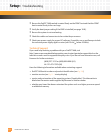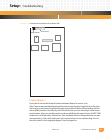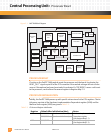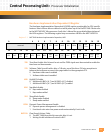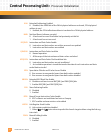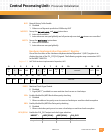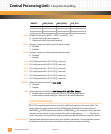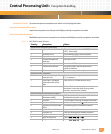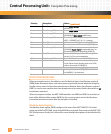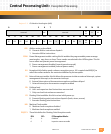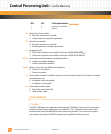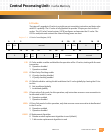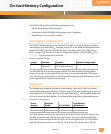
Central Processing Unit: Exception Handling
PmPPC7448 User’s Manual 10006757-02
3-6
PAR: Disable Precharge for ARTRY*, SHD0*, and SHD1* pins
0 Signals driven high when negated
1 Signals not driven high when negated
DFS4: Dynamic Frequency Switching divide-by-four mode
0Disabled
1Enabled
DFS2: Dynamic Frequency Switching divide-by-two mode
0Disabled
1Enabled
PC5: PLL Configuration bit 5 (PLL CFG[5]), read only
PC0: PLL Configuration bit 0 (PLL CFG[0]), read only
PC1: PLL Configuration bit 1 (PLL CFG[1]), read only
PC2: PLL Configuration bit 2 (PLL CFG[2]), read only
PC3: PLL Configuration bit 3 (PLL CFG[3]), read only
PC4: PLL Configuration bit 4 (PLL CFG[4]), read only
SYNCBE: Address Broadcast Enable for sync, eieio
0Disabled
1Enabled
ABE: Address Broadcast Enable for dcbf, dcbst, dcbi, icbi, tlbie, tlbsync
0 Disable address broadcasting for cache and TLB control operations
1 Enable address broadcasting for cache and TLB control operations
EXCEPTION HANDLING
Each CPU exception type transfers control to a different address in the vector table. The
vector table normally occupies the first 0x2000 bytes of RAM (with a base address of
0000,0000
16
) or ROM (with a base address of F800,0000
16
). An unassigned vector position
may be used to point to an error routine or for code or data storage.
Table 3-3 lists the pro-
cessor exceptions starting with the highest priority per the following four exception classes.
Asynchronous: Nonmaskable exceptions have priority over all other exceptions. These exceptions cannot
be delayed and do not wait for completion of any precise exception handling.
Negated 0 1 Bus/2
Negated 1 0 Core
Negated 1 1 Core/2
HRESET*: HID1[ECLK]: HID1[BCLK]: CLK_OUT:



